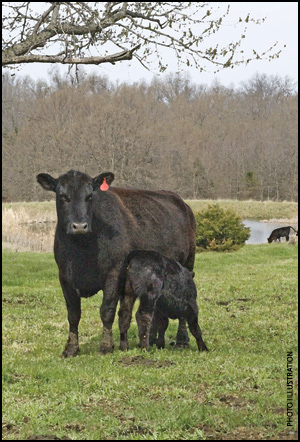HEALTH & NUTRITION...

Lipids and Reproduction:
A Reality Check
While the jury is still out on how extensively lipids influence the reproductive process in cattle, experts stress that a well-balanced program for protein and energy is essential to achieving an animal’s reproductive potential.
For scientists like Rick Funston, beef researcher at the University of Nebraska’s West Central Research and Extension Center, determining the exact role dietary lipids play in beef cattle reproduction has proven to be, more than once, an exercise in frustration. Read more.
Researchers Say Distillers’ Grains
Improve Reproduction
University of Nebraska research shows that feeding dried distillers’ grains (DDGs) to developing heifers can improve reproduction in addition to providing an excellent source of energy and protein for growth.
UNL animal scientists conducted a two-year study at two locations in Nebraska to determine if supplementing beef heifers with DDGs as an energy source affected growth or reproduction. Read more.
Test Bulls for Breeding Soundness
Livestock producers should have their herd bulls examined for breeding soundness before turning them out with cows this summer.
“Veterinarians across the state are reporting higher-than-average rates of bulls failing breeding soundness exams,” says Charlie Stoltenow, North Dakota State University (NSDU) Extension Service veterinarian.
This year’s harsh winter weather may be to blame for at least part of the problem, according to Greg Lardy, NDSU Extension beef cattle specialist. In addition, short feed supplies may have affected nutritional programs that bulls received this winter.
“Poor nutrition can negatively impact semen quality,” Lardy says. “Bulls [that] experience frostbite to testicles also have a higher likelihood of failing the exams. The severity of the injury is related to the likelihood of recovery. The more severe the frostbite, the higher the likelihood semen quality is impacted.”
Even in cases where frostbite is not apparent, semen quality may be affected, so testing each bull prior to spring turnout is imperative, Stoltenow says. Because spermatogenesis takes approximately 60 days, injuries may not be readily apparent immediately after the occurrence of frostbite. Read more.

Bob Larson
Vet Link
Abortions due to IBR and BVD
Protecting breeding herds from diseases that can cause abortions is an important goal of biosecurity and vaccination programs for cow-calf ranches. One aspect of protecting the breeding herd is the investigation of abortions in order to identify the cause of the problem, or — often equally important — to determine that certain abortion-causing agents are not likely to be involved in the current problem. Read more.
Anthrax Vaccinations Recommended
Before Turning Cows to Pasture
A South Dakota State University (SDSU) veterinarian advises cattle producers to include anthrax vaccines in their programs before turning cattle out to summer pasture.
SDSU Cooperative Extension Veterinarian Russ Daly said anthrax, which is caused by bacteria that can exist as spores in the soil for long periods of time, could arise this summer due to conditions that follow a wet spring.
“Flooding can wash anthrax spores up from lower levels of the soil, and the spores can be deposited on grass and other forage cows eat,” Daly said.
All producers are encouraged to use the anthrax vaccine, especially in areas that were previously flooded. The vaccine is widely available, inexpensive and effective. One dose of vaccine at pasture turnout is generally effective for the whole grazing season.
“During the summer, producers should check all cattle daily, and move quickly to investigate unexpected deaths in cows, bulls and calves,” he said. “Like many diseases, prompt action against anthrax can prevent excessive losses.”
Local veterinarians are the best source for information regarding anthrax, according to Daly. The South Dakota Cooperative Extension Service, including Extension Veterinary Science, and the South Dakota Animal Industry Board are other sources of information.
Ridin’ Herd
What size fits?
With high input costs, cattle producers continually refine and evaluate how resources are being allocated. Because feed costs make up the largest portion of annual cow costs, producers look to attack feed costs to make their livestock enterprise competitive. As producers re-evaluate feed inputs, revisiting items that drive nutrient needs of beef cows is a good first step. Beef cattle geneticists make the statement that cow type needs to fit the feed resource of your operation and that different biological types fit better in high-stress and low-stress environments. Feed resources differ from ranch to ranch, and not all cow types will excel in a particular production system. Read more.
Consider Nutritional Influences
Environment and nutrition play an important role in reproductive success in a beef female. While it’s important to select for a balance of traits, producers must also select traits that match animals to their environment.
A cow’s nutrient requirements must be met in order to achieve reproductive success within the herd. And there is no quick fix for reproduction challenges brought on by poor nutrition, one UNL Extension reproductive physiologist notes. Read more.
Cattle Diseases: Common Conditions/Terms
Click here for a list of common conditions and terms related to beef cattle diseases, such as anaplasmosis, brucellosis, BVD, E. coli, IBR and others.





